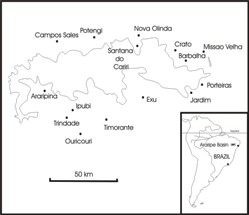 David M Martill* thinks that draconian anti-fossil collecting laws are stifling research and should be scrapped.
David M Martill* thinks that draconian anti-fossil collecting laws are stifling research and should be scrapped.
Geoscientist 21.10 November 2011
I was delighted to read a response by Langer et al. 1 to comments regarding the collection of fossils in Brazil in an earlier feature I had written 2 about the Crato Formation. The authors seem very proud of their laws, but I think they do a grave disservice to science and to their own people. Let me explain why.
Image: Outline of the Chapada do Araripe in Brazil and the main population centres of the region.
Sadly, Brazil as a country suffers from endemic corruption, which is a way of life in parts of the country - a pragmatism that ‘oils the wheels’ of a well established system. Some of the pettiest operates in rural Ceará, a fossil-rich state of Brazil’s semi-arid north-eastern corner. This corruption permits a global fossil-exporting industry worth millions to flourish.
Some people (Langer et al. doubtless among them) think such a trade is “a bad thing” and want it stopped. I don’t: I want to see it expanded. I want it to thrive. I want to see so many fossils flooding out of Brazil (and China and Argentina) that the prices come tumbling down. I want to see quarries all along the fossiliferous outcrops of Brazil’s Chapada do Araripe with people digging night and day. I dream of fossil shops around the World stuffed with Brazilian fishes, pterosaurs, dinosaurs, insects and plants in abundance.
Oh wait a minute… they already are. You see, to protect Brazil’s fossil heritage from commercial dealers, as some would advocate, you need to stamp out Brazil’s grass-root corruption and that will never happen. The illegal export of Brazil’s fossil heritage will continue for as long as there is a market.
Don’t get me wrong, the law can and will be applied, but only to squeeze out competition, and a commercial monopoly will be the reward of whoever pays the biggest bribes. When a pterosaur skull can go for US$300,000, those bribes can be substantial. The law can also be used to exclude foreign scientists (like me) from ‘competing’ with Brazilian scientists.
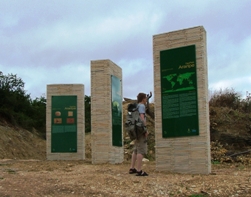 INEFFECTUAL
INEFFECTUAL
That the laws aimed at protecting Brazil’s fossils are hopelessly ineffectual is not actually the point. Even if the law did deter, what is the point of protecting fossils? This question applies not only to Brazil; it can be posed to all countries with draconian rules on fossil collecting and exporting, (including China, where even the death sentence seems no deterrence, and Australia, where they are nevertheless happy to sell Brazilian and Moroccan fossils in the gift shops of their national museums).
Image: The Crato Formation Geotope south of Nova Olinda in Ceará. Display boards explain the palaeontological and commercial importance of this finely laminated limestone in both Portuguese and English.
The palaeontological resource of the Chapada do Araripe Geopark is vast. It is approximately 150km by 50km with an outcrop of the Crato and Santana formations around its flanks extending for more than two thirds of the perimeter of the chapada. Thus, there are around 450km of outcrop of the fossiliferous nodule-bearing Santana Formation.
The thickness of the concretion-bearing outcrop varies from as little as two or three metres in some places, but it maybe as thick as 10 metres. Even with a conservative outcrop width of as little as 50m, there are at least 250km2 of outcrop, and everywhere it is full of fossils. It is possible to estimate the abundances of some fossil species with back-of-envelope calculations.
Take the little fish Dastilbe sp. from the Nova Olinda Member of the Crato Formation. It is extremely common, occurring as isolated specimens and as mass mortality accumulations. In the region between Nova Olinda, Santana do Cariri and Tatajuba on the north side of the Chapada, the Nova Olinda Member is, on average, about eight metres thick. Approximately one specimen of Dastilbe occurs per metre of bedding plane exposed, and the limestone is bedded on a millimetre scale.
To keep the numbers simple, assume one Dastilbe per square metre for every 10cm of vertical section thickness; each square metre of exposure will yield approximately 80 Dastilbe. Some slabs will have more, some may have none; but the figure is a reasonable average, and of course only every tenth centimetre of the succession is considered here. The Nova Olinda Member has a continuous exposure around the flanks of the valley of the Rio Carius of c.17km from Nova Olinda to Tatajuba via Santana do Cariri, and Araporanga. Assuming an average outcrop width of 100m, this gives 1,700,000m2 of accessible exposure. With 80 per square metre, this means that around 136 million specimens of Dastilbe are being ‘protected’ by ineffectual legislation.
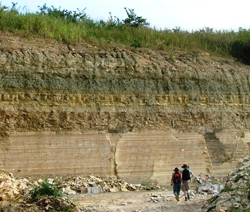 ILLEGAL
ILLEGAL
Of course, these laws are designed to protect very rare, scientifically ‘important’ fossils (leaving aside how, and by whom judged). But rare fossils stay rare if no one is allowed to dig for them. All these laws are quaintly naïve, none of them protecting Brazilian fossils. They make it illegal to collect Brazilian fossils for a private collection and export them without a licence and are detrimental to international palaeontology.
Image: The Nova Olinda Member limestone (laminated unit at base of quarry)
I don’t condone the blatant breaking of the law, but here is the reality. In the Araripe Basin fossils are collected by ‘fossil diggers’, poor farm workers prepared to dig deep and dangerous excavations to collect fossils that they sell for just a few dollars. They are also collected by quarry workers excavating limestone slabs in the Nova Olinda district (if they didn’t, the fossils would be thrown away and lost forever). They are then sold to middlemen who pass them on to European, American and Japanese traders, often through dealers based in São Paulo, Fortaleza and elsewhere in Brazil. The price increases (almost exponentially) from discovery to the large Arizona (Tuscon), German (Munich) or Japanese (Tokyo) fossil fairs. This trade has not stopped, and appears to be increasing, especially for the more spectacular fossils such as pterosaurs and other, even rarer tetrapods.
From Ipanema market and the tourist shops of the Copacabana in Rio de Janeiro, fossils have ‘disappeared’. But a quiet word in some of the larger gem dealers showrooms might still get you a large Cretaceous coelacanth (I know – I was offered such rare fossils at a ‘good price’). Occasionally the Brazilian police intercept consignments of fossils destined for export. Dr Andre Herzog, formerly Rector of the Universidade Regional do Cariri (URCA), has shown me what happens to such confiscated fossils. Intercepted at the ports, the contraband is transported to Crato and held by the DNPM (the Departmento Nacional Produção Mineral), an agency more or less equivalent to a national geological survey. The photo shows what happens next. They are left to rot.
So we must assume that all of the wonderful Brazilian fossils offered for sale around the world are either exported with a licence, or collected before 1988, or illegal. Many commercial dealers state on their web sites that fossils for sale are from old collections (this is mostly nonsense, given away by the fact that some of the sites yielding characteristic fossils were not discovered until after 1988). The fossils must therefore be illegal. But so what?
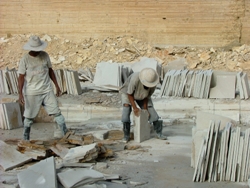 Image: Quarry workers extracting paving stone from the Nova Olinda Member limestone. They find hundreds of fossils every day. Brazilian law does not allow them to sell them, so many simply get thrown onto waste dumps.
Image: Quarry workers extracting paving stone from the Nova Olinda Member limestone. They find hundreds of fossils every day. Brazilian law does not allow them to sell them, so many simply get thrown onto waste dumps.
Consider this - The Chapada do Araripe is mineral-rich. Strata between the fossiliferous Crato and Santana formations contain evaporite seams more than 10m thick - the richest source of gypsum in South America. To extract this, multinational mining companies (such as French-owned Holcim) as well as smaller national companies in extensive quarrying operations around Ipubi and Araripina, remove overburden to extract the gypsum.
This overburden includes the Santana Formation nodule beds, and each overburden removal operation destroys thousands of wonderful fossils. I have walked over the spoil dumps picking up broken fishes in nodules rescuing them from reburial under another dump truck full of dirt.
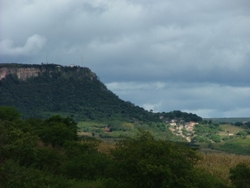 OBSCENE
OBSCENE
I find it obscene that a mining company can legitimately destroy perhaps millions of fossils annually, while a Brazilian cannot keep a fossil collection without a licence, and a bona fide scientist must get permission to collect a few samples that they are later forced to give up (I am still awaiting a reply following a visit to the Brazilian Embassy in London to discuss permission two years ago). In Britain we are aware that every year huge numbers of fossils are destroyed or damaged by the heavy machinery that relentlessly excavates our raw materials. Enlightened quarry owners allow amateur collectors to salvage some. Thus was the fish-eating theropod dinosaur Baryonyx discovered.
Image: View of the Chapada do Araripe above Santana do Cariri, showing the Cancau Geotope. This site provides a spectacular vista of the Chapada. The restaurant serves excellent lunches at weekends.
In Britain we are aware that amateur collectors make a valued and significant contribution to our science. Indeed, our premier palaeontological scientific body, the Palaeontological Association, annually awards a prize to amateur fossil collectors as a way of acknowledging their very significant contributions to our science. This laissez faire attitude to collecting dates back a long way. Mary Anning, darling of British 18th century vertebrate palaeontology is considered one of the 10 most significant women in 19th Century science. She was a commercial fossil dealer.
The UK’s lack of laws “protecting” fossils permits young and old alike to build extensive collections, even from our World Heritage Jurassic Coast. This surely is the best approach. The small army of amateur and professional collectors have unearthed such delights as Baryonyx walkeri, a spectacular spinosaurid dinosaur discovered by amateur fossil hunter William Walker; Caulkicephalus trimicrodon, a toothy pterosaur similar to the Brazilian Anhanguera found by school boy Dan Davies (age 7) on his holidays, and ‘Lizzie’ (Westlothiana lizziae), perhaps the oldest reptile yet discovered, found by Scottish commercial palaeontologist Stan Wood. To name but three.
Britain’s fossil-rich coastline is regularly beaten by Atlantic tempests and icy Arctic storms. While this reveals millions of new fossils every year, it also destroys millions too. Our amateur collectors save many before they succumb to the wave. To outlaw collecting would banish them for ever. The Araripe Basin, while far from the sea, nevertheless has its own climatic problems affecting its fossils. Rapid erosion from tropical downpours and deep tropical weathering hardly enhance the fossils. On the ground, concretions are superabundant with perfect fossils, often with preserved soft tissues.
There are numerous sites (hundreds) where stream beds are littered with concretions, all containing fishes. The only reason that I have not collected them is because I could not carry them all. In ploughed fields on the outcrop of the Romualdo Member, the ground is littered with concretions. Where farmers do not tolerate boulders in their fields, concretions have been piled up, making collecting even easier! I have mapped the Romualdo Member on the southern flank of the Chapada by sitting on a hill and using my binoculars to look for brash-covered fields.
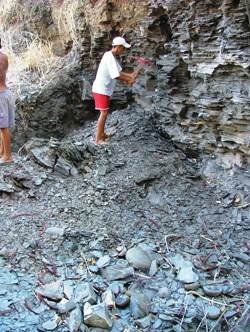 PALAEOKLEPTOPHOBIA
PALAEOKLEPTOPHOBIA
In this field brash fossils are weathering away, as the tropical climate causes the concretions to break down physically and chemically. Sao Paulo journalist Cristina Amorim, to whom I showed this phenomenon, flatly refused to collect one perfect 3D specimen of Rhacolepis (out of hundreds) in a stream-bed at Cajazeiras - in case she got caught with it by the Federal authorities. So we left it - for the next rain storm to flush downstream and smash it to pieces. This fear of owning a fossil – palaeokleptophobia – clearly does so much to protect Brazil’s palaeontological patrimony.
Image: Outcrop of the Romualdo Member of the Santana Formation, showing fossil-bearing the early diagenetic carbonate concretions at Sobradinho.
Every day, hundreds of tonnes of fossiliferous laminated limestone are quarried by hand from the Crato Formation. Many eyes see many fossils and, as the fossils have monetary value, quarrymen pop them into little cloth bags and pass them to dealers for a few Reais. What happens if the market disappears? In one quarry near Tatajuba the owner has instructed his workers not to collect, to avoid trouble with the authorities. Instead they are simply tipped from a wheelbarrow down a 10-metre slope, never to be seen again.
One Saturday lunchtime I was at the gate of the stone quarries of the Rio Jacu, about three kilometres south of Nova Olinda. Several of the quarrymen were eagerly awaiting their pay packets and as I rolled up most of them clamoured to show me the fossils they had collected that morning. I was offered an amazing assortment of fossil insects and fishes and began to examine them under the hand lens. Some were exquisite, quite fresh, and with no crude preparation marks.
I was examining a specimen when an man, eager to get his fossil bought before my cash ran out (admissions such as this have brought me into conflict with Brazilian authorities), thrust a specimen under my nose. I gestured that I would look at it in a moment, but he assumed was waving it away as worthless and threw it as far as he could. Yet from the brief glimpse I had, I could tell it was a stunning beetle: beautifully preserved, and quite rare. This is what happens if the commercial market disappears.
INFLATED
Wildlife is protected because if enough are killed, the species ceases to be. Most people can understand the sense of that. Fossils are already dead. So why are they protected? Most people will say because some are very rare and of scientific value, or that while they are in situ they are in context, and hence more useful. But blanket legislation preventing the collecting of fossils helps make fossils rare. Many fossils are known from only one example. Stopping people collecting prevents more from being discovered. In fact, were I an illegal fossil dealer with scant regard for the law, I might want things to stay that way, just to keep prices inflated.
‘Protecting fossils’ criminalises palaeontologists. Laws banning fossil collecting and private fossil collections deter amateur palaeontologists, drive them underground and stifle curiosity. Fossils left in the ground weather away and are lost. Banning commercial collecting loses tax revenue.
Fossils are for everyone. Most private collections of any merit eventually find their way into a museum, bequeathed or sold into the public domain. They have been hidden for millions of years; we can afford to wait a few more. After all, there is another generation of palaeontologists coming up behind.
May the more enlightened palaeontologists in countries with draconian laws lobby to have them repealed. Then we can all get some science done.
References
- Letter, Geoscientist 21.01 February 2011, p22.
- Martill, M & Heads, S 2007: Out of Eden Geoscientist 17.11 pp20-24
*Palaeobiology Research Group, School of Earth and Environmental Sciences, University of Portsmouth, Burnaby Road, Portsmouth PO1 3QL UK E: [email protected]